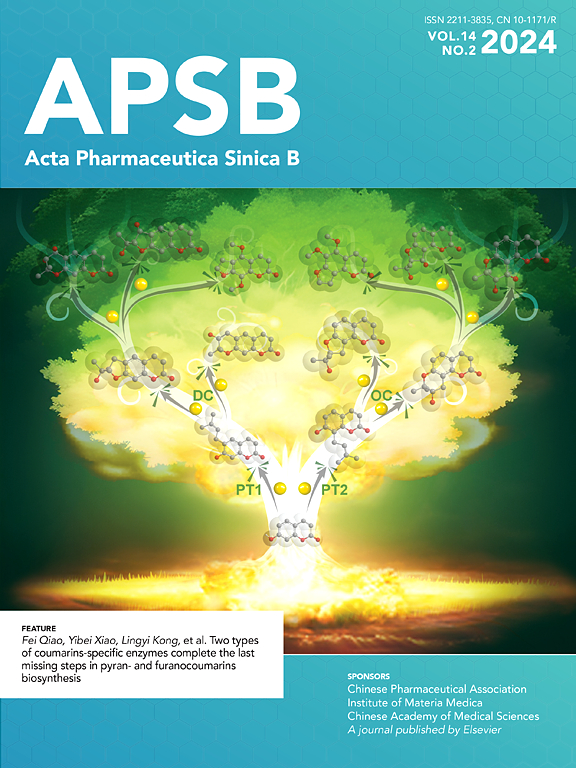p52-ZER6/DAZAP1 axis promotes ferroptosis resistance and colorectal cancer progression via regulating SLC7A11 mRNA stabilization
IF 14.7
1区 医学
Q1 PHARMACOLOGY & PHARMACY
引用次数: 0
Abstract
Resistance to ferroptosis, a form of regulated cell death caused by disruptions in iron ion and intracellular redox homeostasis, is closely related to tumorigenesis and tumor drug resistance; therefore, targeting ferroptosis-related pathways has garnered attention as a potential antitumor therapeutic strategy. However, the molecular mechanisms underlying ferroptosis resistance in tumor cells remain unknown. Zinc-finger estrogen receptor interaction clone 6 (ZER6) consists of two isoforms with distinct N-termini, p52-ZER6 and p71-ZER6. ZER6 is upregulated in tumors and promotes tumorigenic potential; however, whether ZER6 is involved in tumor cell ferroptosis resistance remains unknown. Herein, we identified p52-ZER6 as a novel regulator of tumor cell ferroptosis resistance. p52-ZER6 promotes the transcriptional activity of DAZAP1, an RNA-binding protein. DAZAP1, in turn, enhances the stability of SLC7A11 mRNA by binding to its 3′-UTR region, thereby increasing SLC7A11 expression and cellular glutathione levels. This subsequently reduces lipid peroxide accumulation and enhances tumor cell ferroptosis resistance, eventually promoting tumorigenic potential. These findings reveal a new function of p52-ZER6 in regulating SLC7A11 mRNA stability via DAZAP1, ultimately leading to ferroptosis resistance and tumorigenic potential. Additionally, we also suggest targeting p52-ZER6 as a potential strategy to promote the efficacy of ferroptosis-based antitumor therapies.

p52-ZER6/DAZAP1轴通过调节SLC7A11 mRNA稳定促进铁下垂抵抗和结直肠癌进展
铁凋亡是一种由铁离子破坏和细胞内氧化还原稳态引起的受调节细胞死亡形式,对铁凋亡的抵抗与肿瘤发生和肿瘤耐药密切相关;因此,靶向凋亡相关途径作为一种潜在的抗肿瘤治疗策略已引起人们的关注。然而,肿瘤细胞耐铁下垂的分子机制尚不清楚。锌指雌激素受体相互作用克隆6 (ZER6)由p52-ZER6和p71-ZER6两个具有不同n端的同工异构体组成。ZER6在肿瘤中上调,促进致瘤潜能;然而,ZER6是否参与肿瘤细胞对铁下垂的抵抗尚不清楚。在这里,我们发现p52-ZER6是肿瘤细胞铁下垂抗性的一种新的调节因子。p52-ZER6促进DAZAP1(一种rna结合蛋白)的转录活性。而DAZAP1通过结合SLC7A11 mRNA的3 ' -UTR区,增强SLC7A11 mRNA的稳定性,从而提高SLC7A11的表达和细胞谷胱甘肽水平。这随后减少脂质过氧化积累,增强肿瘤细胞对铁下垂的抵抗力,最终促进致瘤潜能。这些发现揭示了p52-ZER6通过DAZAP1调控SLC7A11 mRNA稳定性的新功能,最终导致铁下垂抵抗和致瘤潜能。此外,我们还建议靶向p52-ZER6作为一种潜在的策略来提高基于铁中毒的抗肿瘤治疗的疗效。
本文章由计算机程序翻译,如有差异,请以英文原文为准。
求助全文
约1分钟内获得全文
求助全文
来源期刊

Acta Pharmaceutica Sinica. B
Pharmacology, Toxicology and Pharmaceutics-General Pharmacology, Toxicology and Pharmaceutics
CiteScore
22.40
自引率
5.50%
发文量
1051
审稿时长
19 weeks
期刊介绍:
The Journal of the Institute of Materia Medica, Chinese Academy of Medical Sciences, and the Chinese Pharmaceutical Association oversees the peer review process for Acta Pharmaceutica Sinica. B (APSB).
Published monthly in English, APSB is dedicated to disseminating significant original research articles, rapid communications, and high-quality reviews that highlight recent advances across various pharmaceutical sciences domains. These encompass pharmacology, pharmaceutics, medicinal chemistry, natural products, pharmacognosy, pharmaceutical analysis, and pharmacokinetics.
A part of the Acta Pharmaceutica Sinica series, established in 1953 and indexed in prominent databases like Chemical Abstracts, Index Medicus, SciFinder Scholar, Biological Abstracts, International Pharmaceutical Abstracts, Cambridge Scientific Abstracts, and Current Bibliography on Science and Technology, APSB is sponsored by the Institute of Materia Medica, Chinese Academy of Medical Sciences, and the Chinese Pharmaceutical Association. Its production and hosting are facilitated by Elsevier B.V. This collaborative effort ensures APSB's commitment to delivering valuable contributions to the pharmaceutical sciences community.
 求助内容:
求助内容: 应助结果提醒方式:
应助结果提醒方式:


